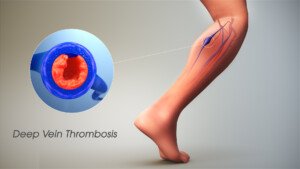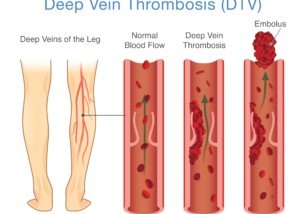What are the telltale signs of a blood clot that your fingertips can detect if you feel along the suspected area?
A DVT is a life-threatening condition because it can break off, travel to the lungs and potentially completely block blood flow.
DVT stands for deep vein thrombosis.
If you just happen to be running your fingers along your legs, particularly areas where there’s only a thin layer of fat, you may feel all sorts of lumps, bumps and knot-like things.
Depending on what type of health anxiety you’re afflicted with, your mind may immediately jump to bone cancer, lymphoma, sarcoma, a metastatic cancer or blood clots.
Feeling a Blood Clot with Your Fingertips
Yes, this is possible.
“You can only feel a blood clot in the leg with your fingers if the blood clot is occurring on a surface vein,” says Dr. Lawrence Presant, DO, chief medical officer at Arizona Vein Specialists.
“Swelling in the leg and a painful blue and purple lump could indicate a surface vein blood clot,” says Dr. Presant.
The clot will usually feel cord-like, and the track along the vein may be reddish.
These superficial clots, also called superficial thrombophlebitis, are nothing to worry about, even though they can be painful or tender.
The type of clot to worry about, however, is the DVT: deep vein thrombosis.

Scientific Animations, Creative Commons/BY-SA/Attribution-ShareAlike 4.0 International
“A deep vein blood clot will only be visible during an ultrasound,” says Dr. Presant.
When a DVT is suspected, a doctor or nurse won’t be palpating (feeling) the legs for one of these.
That’s because they’re in deep veins, hence the name. If something’s in a deep vein, there’s no way that fingers – even an experienced physician’s – can detect this.
Ultrasound is the first mode of diagnostics when a DVT is suspected.
However, your fingers can detect the signs of a DVT, which usually develops in the lower leg, but can also occur in the upper leg.
The classic signs in one’s leg are swelling, warmth, redness, tenderness, soreness and/or cramping.
But can your fingers ever feel the actual clot itself? Never.
Also keep in mind that sometimes, a DVT will not produce symptoms.
- If you can feel a blood clot, then this means it’s superficial and not deep.
- Do not be alarmed.
 Dr. Lawrence Presant, DO, is chief medical officer at Arizona Vein Specialists in Phoenix, and a certified diplomat of the American Board of Venous and Lymphatic Medicine. A vein surgeon specialist, his passion is phlebology, the diagnosis and treatment of painful and unsightly vein disorders.
Dr. Lawrence Presant, DO, is chief medical officer at Arizona Vein Specialists in Phoenix, and a certified diplomat of the American Board of Venous and Lymphatic Medicine. A vein surgeon specialist, his passion is phlebology, the diagnosis and treatment of painful and unsightly vein disorders.
 Lorra Garrick is a former personal trainer certified through the American Council on Exercise. At Bally Total Fitness she trained women and men of all ages for fat loss, muscle building, fitness and improved health.
Lorra Garrick is a former personal trainer certified through the American Council on Exercise. At Bally Total Fitness she trained women and men of all ages for fat loss, muscle building, fitness and improved health.
.















